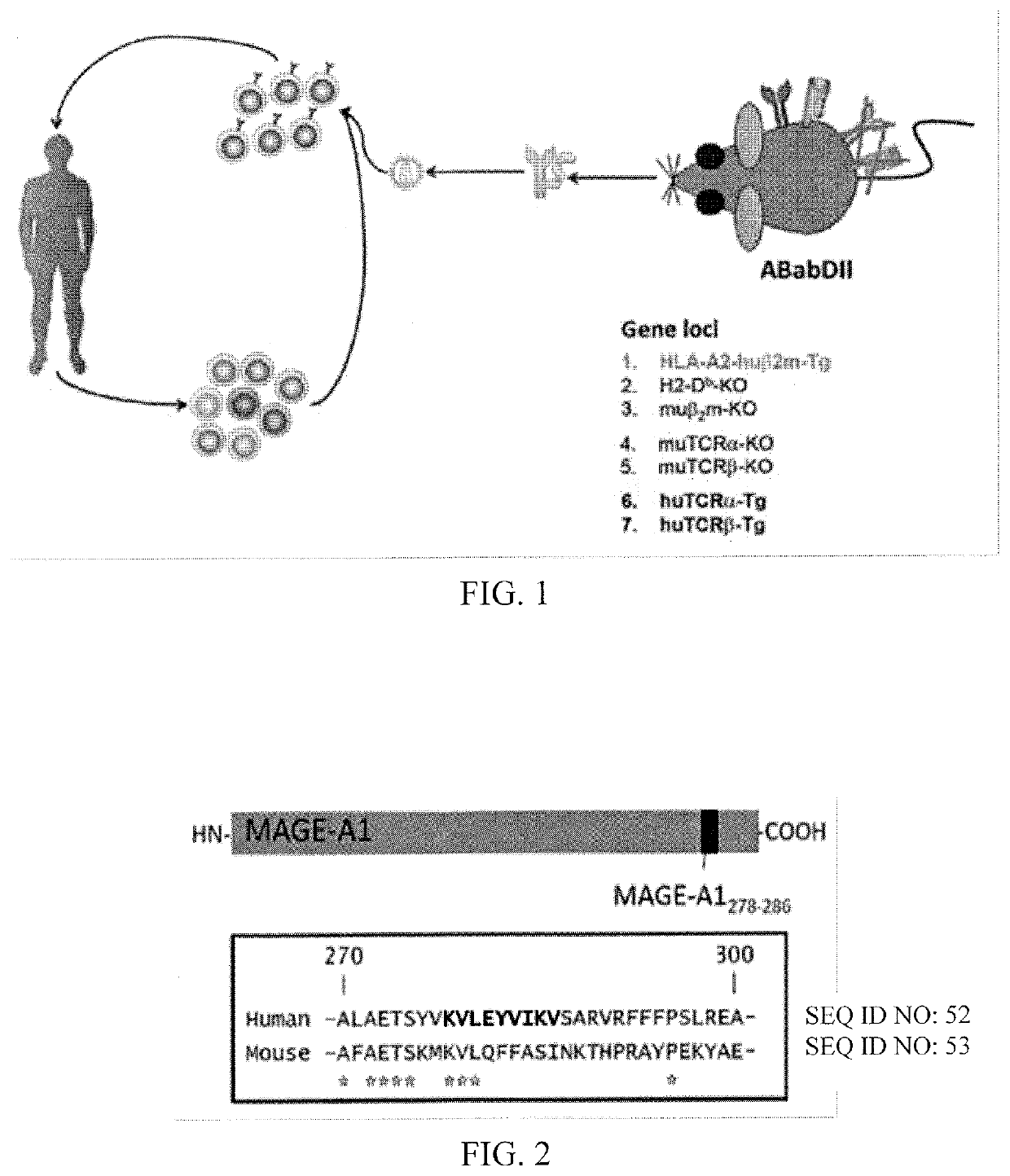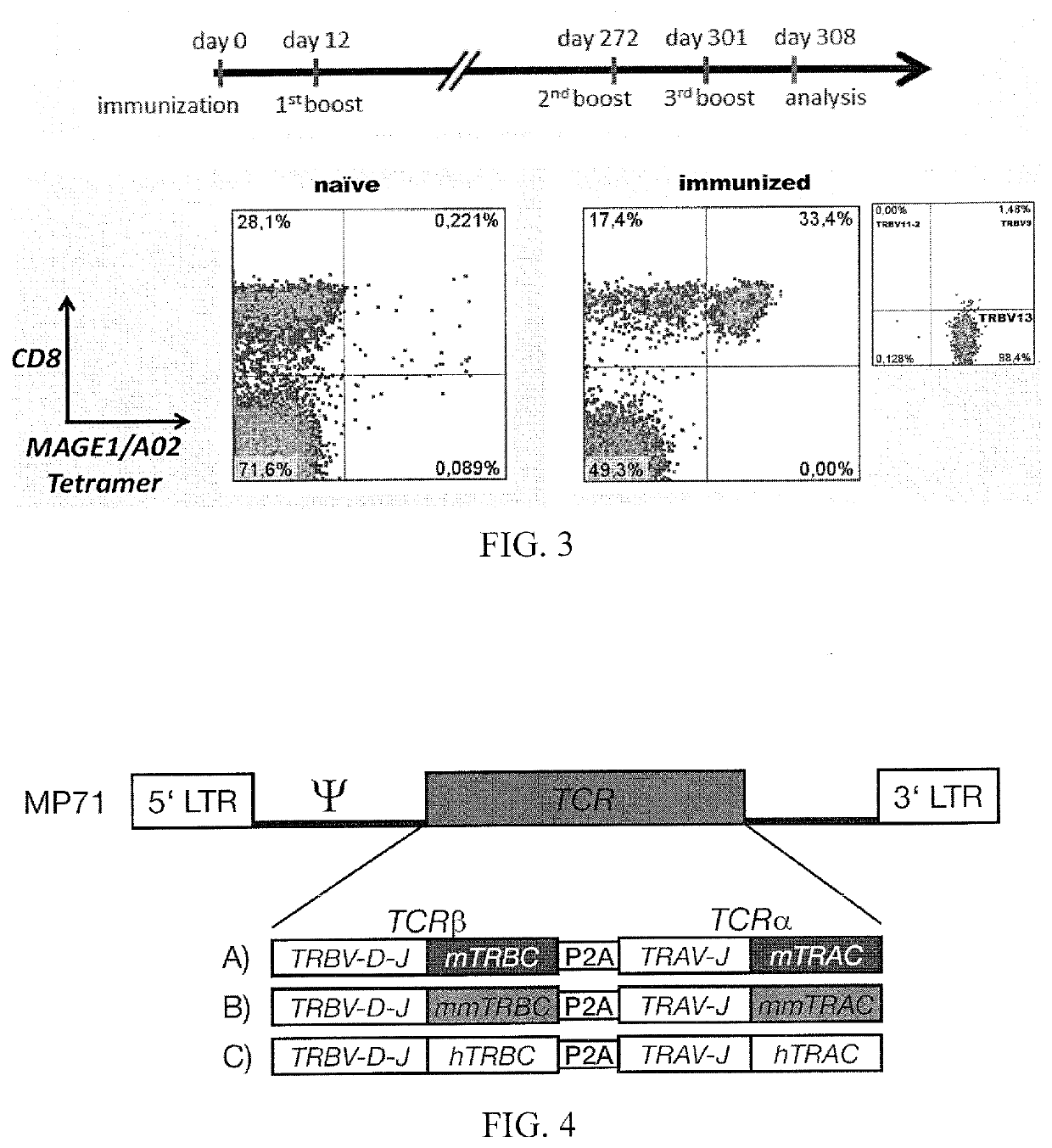High avidity antigen recognizing constructs
a high avidity, antigen-recognizing technology, applied in the direction of instruments, drug compositions, peptides, etc., can solve the problems of affecting the full use of this approach in cancer treatment, many patients cannot be cured, poor prognosis, etc., and achieve the effect of high avidity
- Summary
- Abstract
- Description
- Claims
- Application Information
AI Technical Summary
Benefits of technology
Problems solved by technology
Method used
Image
Examples
example 1
n of T-Cells with a MAGE Epitope using the ABabDII Mouse
[0096]FIG. 2 shows the location of the HLA-A2 restricted epitope MAGE-A1278-286 is shown in relation to the full-length MAGE-A1 protein (top). The human MAGE-A1278-286 epitope is sufficiently different from its mouse homologue to prevent tolerance against human MAGE-A1278-286 in ABabDII mice (bottom).
[0097]MAGE-A1 is expressed in a variety of human tumors, whereas its expression on normal human tissue is believed to be restricted to the testes. Therefore, specific targeting of MAGE-A1 expressing cells should limit toxicity to a minimum.
[0098]ABabDII mice were immunized with a 30mer peptide encompassing the nonamer MAGE-A1278-286 plus CpG in incomplete Freund's adjuvant. Boosts were performed with the nonamer MAGE-A1278-286 plus CpG in incomplete Freund's adjuvant. On the day of analysis, blood was taken and stained with a MAGE-A1 / HLA-A2 specific tetramer and with antibodies for certain TRBV chains (IMGT nomenclature). After sev...
example 2
and Characterization of T Cell Receptors
[0099]The cDNA from MAGE-A1 specific T cell clones as generated in Example 1 was amplified by 5′-RACE and sequenced.
[0100]The table 1 shows the amino acid sequences of complementary determining region 3 (CDR3) of the alpha and beta chains for three different TCRs from ABabDII mice and two TCRs obtained from healthy humans (Ottaviani, S., Zhang, Y, Boon, T., & van der Bruggen, P. (2005). A MAGE-1 antigenic peptide recognized by human cytolytic T lymphocytes on HLA-A2 tumor cells. Cancer Immunology, Immunotherapy: CII, 54(12), 1214-1220.).
TABLE 1Amino acid sequences of the CDR3-regions for three different MAGE-A1 specific TCRs.TCRalpha chain CDR3beta chain CDR31367TRAV5-CAESIGSNSGYALNF-TRAJ41TRBV28-CASRGLAGYEQYF-TRBJ2-7(SEQ ID No. 1)(SEQ ID No. 4)1405TRAV13-1-CAARPNSGNTPLVF-TRAJ29TRBV29-1-CSVEQDTNTGELFF-TRBJ2-2(SEQ ID No. 2)(SEQ ID No. 5)1705TRAV12-3-CAMSDTGNQFYF-TRAJ49TRBV13-CASSFRGGGANVLTF-TRBJ2-6(SEQ ID No. 3)(SEQ ID No. 6)CTL27*TRAV5-CAESYN...
example 3
ty and Specificity of the TCR of the Invention
[0107]MAGE-A1278 antigen was presented on T2 cells. The antigen presenting T2 cells were co-cultured with T-cells expressing the TCR of the invention or a control TCR (CTL27). As shown in FIG. 17 T cells modified with inventive TCRs from ABabDII mice (solid lines) respond to lower amounts of antigen than those modified with a human TCR (dash-dotted line). (One representative example out of 3 independent experiments is shown). These results indicate the surprisingly improved (by at least one order of magnitude) sensitivity of the TCR of the invention compared to state of the art TCR.
[0108]In order to test the specificity of the TCR of the invention over closely related MAGE antigenic epitopes, the TCRs were brought into contact with the MAGE antigens KVLEFVAKV (MAGE-B16) (SEQ ID NO:54) and KVLEYLAKV (MAGE-B5) (SEQ ID NO:55). The antigens were presented by T2 cells which were then co-cultured with T-cells expressing the TCR of the inventio...
PUM
| Property | Measurement | Unit |
|---|---|---|
| concentration | aaaaa | aaaaa |
| concentration | aaaaa | aaaaa |
| concentration | aaaaa | aaaaa |
Abstract
Description
Claims
Application Information
 Login to View More
Login to View More - R&D
- Intellectual Property
- Life Sciences
- Materials
- Tech Scout
- Unparalleled Data Quality
- Higher Quality Content
- 60% Fewer Hallucinations
Browse by: Latest US Patents, China's latest patents, Technical Efficacy Thesaurus, Application Domain, Technology Topic, Popular Technical Reports.
© 2025 PatSnap. All rights reserved.Legal|Privacy policy|Modern Slavery Act Transparency Statement|Sitemap|About US| Contact US: help@patsnap.com



